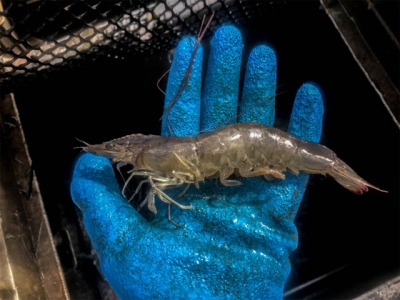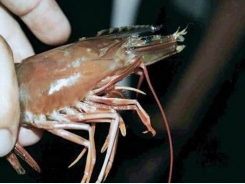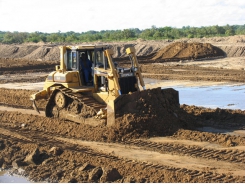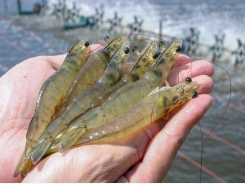Testing soy-optimized feeds and automated feeding systems in shrimp pond production Part 1

Combining plant-based diets and advanced feeding technologies can provide unique advantages to commercial producers
Results of a three-year study testing soy-optimized feeds and automated feeding systems in shrimp pond production show that combining plant-based diets and advanced feeding technologies can provide unique advantages to commercial producers. Note average size of shrimp harvested.
Shrimp are one of the most valuable traded seafood items, and the Pacific white shrimp (Litopenaeus vannamei) is the preferred shrimp species for aquaculture due to its capacity to grow in a wide range of culture environments. Feed is the most important variable cost and source of nutrients, and consequent biological waste in semi-intensive and intensive aquaculture systems. Currently available shrimp feeds are generally adequate and there is considerable knowledge and numerous research and commercial demonstrations of soy-based feeds with limited or no animal protein. Such feed would be considered much less costly and a more sustainable alternative to fishmeal-based feeds.
Although improved feeds are available to enhance sustainability, they must be matched with optimized feed delivery. Following the footsteps of other subsectors of agriculture, the aquaculture industry has been moving towards increasingly automated feeding systems for a wide variety of tasks. Automatic feeding systems have achieved a pivotal role in aquaculture intensification for fish and these technologies are now being applied to shrimp production.
Shrimp are grazers with limited capacity to store feed in their digestive tract, which results in slower continued ingestion of small quantities of feed. Hence, multiple studies have shown enhanced growth performance of shrimp with multiple feedings through the day. However, multiple daily feeding applications can be very labor-intensive and economically impracticable in many regions.
To further complicate management, unlike in fish systems where there is often direct observation of feeding behavior, traditional feed management techniques for shrimp are indirect and after the fact. Feed inputs are often estimated through feed tables, observation from feeding trays, visual confirmation of the gut, or a combination of various indirect measures. Such techniques are useful, but they are not real-time. As a response to the necessity of the shrimp farming industry to improve its feed management protocols, automated technologies have been developed and are now being employed by numerous farmers worldwide.
A unique feature of shrimp is that they externally masticate their feed. This particular feeding activity is acoustically active producing a distinctive clicking noise as food is shredded and has led to the development of an acoustic demand-feeding system which has been proven to be a reliable tool in shrimp farming. Previous works by Jescovitch et al. (2018), Ullman et al. (2018) and Ullman et al. (2019) have shown improvements in growth performance by application of acoustic demand-feeding system in comparison to two hand-feeding per day or timer based feeders which deliver feed multiple times per day.
Over the last two years at our research production facility we have transitioned from two feedings per day running a 120-day production cycle to the use of automated feeding systems running a 90-day production cycle. Despite reducing the production cycle by 30 days we are producing a larger biomass and shrimp of larger size. This is accomplished as the automated feeding systems allow for more feeding and thus higher consumption of feed, which in turn promotes faster growth.
The present study builds off the previously mentioned research, which developed soy-optimized feeds to reduce feed costs and present a more sustainable feed, primarily based on sustainable plant-based ingredients. This feed was then used to demonstrate the use of soy-optimized production diets and to improve the efficacy of automated feeding systems for shrimp.
The objective of our work has been improving the understanding and practical functionality of automated systems, concentrating on improving timer-feeder protocols by slowly increasing feed quantities using increased frequency of scheduled meals. It has been carried out in parallel with an acoustic demand-feeding system (AQ1 Systems,Tasmania, Australia), which has allowed the validation of this technology under a practical production scenario. In addition to a practical feed demonstration using new automated technology, these data demonstrate the efficacy and performance of shrimp on soy-optimized feeds.
1/ Study design
The research was performed at the Alabama Department of Conservation and Natural Resources, Claude Peteet Mariculture Center, Gulf Shores, Alabama (USA). Pacific white shrimp (L. vannamei) larvae were obtained from Shrimp Improvement Systems (Islamorada, Fla., USA), acclimated and nursed in a greenhouse system. Juvenile shrimp were then stocked into 16 outdoor, 0.1-hectare (ha) ponds at 17 shrimp per square meter in 2016, 38 shrimp per square meter in 2017 and 26 shrimp per square meter in 2018.

Views of the setup for shrimp pond with BioFeeder timer feeders.
2/ Feed management
All ponds were offered the same two diets: 1.5-mm commercial diet (40 percent crude protein, 9 percent crude lipids) produced by Zeigler Bros. Inc. (ZBI, Garners, Pa., USA) for the first four weeks, and 2.4-mm 35 percent protein, 8 percent lipid diet produced by ZBI was fed from the fourth week on. In 2016 and 2018 the production diet was a soy-optimized feed, and in 2017 a commercial shrimp diet, SI-35 was fed. Three treatments were evaluated each year based on a standard feeding protocol (SFP) calculated based on an expected weight gain of 1.3 grams per week, a feed conversion ratio (FCR) of 1.2, and expected population based on a 1.5 percent weekly mortality during the grow-out period.
The first year of research compared hand-feeding twice daily using the SFP, SFP +15 percent, and SFP +15 percent using a solar timer feeder (Solarfütterer, FIAP GmbH, Ursensollen, Germany) that fed six times per day between 8 a.m. to 6 p.m. and the fourth treatment was self-managed using the AQ1 acoustic feeding system, which allowed feeding from 7 a.m. to 1 p.m. The second year compared hand feeding SFP, two solar timer feeder treatments feeding SFP +15 percent and SFP +30 percent, as well as the AQ1 acoustic feeding system. The present research removed the hand feeding treatment and switched to a timer feeder that allowed more than six feedings per day. The three timer treatments were SFP +30 percent, SFP + 45 percent, SFP + 60 percent and the AQ1 feeding system.
The current feeders used for SFP treatments were BioFeeder (BioFeeder SA, Guayaquil, Ecuador) timer-feeders, set to feed once every 20 minutes from 7 a.m. to 7 p.m., resulting in 36 feedings per day. The feeders were controlled remotely using the feeder’s specific web-based software that can be accessed from any computer or phone. The AQ1 feeding system fed ad libitum using a hydrophone with computer software to monitor feeding activity.
In the most recent research, in an attempt to not limit the feeding to daytime hours, the AQ1 system was also equipped with an underwater DO sensor and the system was set to only allow feeding when DO levels were above 4 mg/L. In all four ponds using the AQ1 system, the main aerator was connected to the controller to automate the aerator activity based on the DO sensor measurements. The system turned on the aerator below a DO threshold and paused the feeder until the DO was above a set level in which the aerator turned off. AQ1 treatment were non-randomly assigned to ponds due to power supply restrictions.

View of the BioFeeder dashboard showing important production and management data.
Có thể bạn quan tâm
Phần mềm

Phối trộn thức ăn chăn nuôi

Pha dung dịch thủy canh

Định mức cho tôm ăn

Phối trộn phân bón NPK

Xác định tỷ lệ tôm sống

Chuyển đổi đơn vị phân bón

Xác định công suất sục khí

Chuyển đổi đơn vị tôm

Tính diện tích nhà kính

Tính thể tích ao hồ




 Testing soy-optimized feeds and automated feeding systems in…
Testing soy-optimized feeds and automated feeding systems in…  Shrimp given plasma can grow almost 10% bigger,…
Shrimp given plasma can grow almost 10% bigger,…